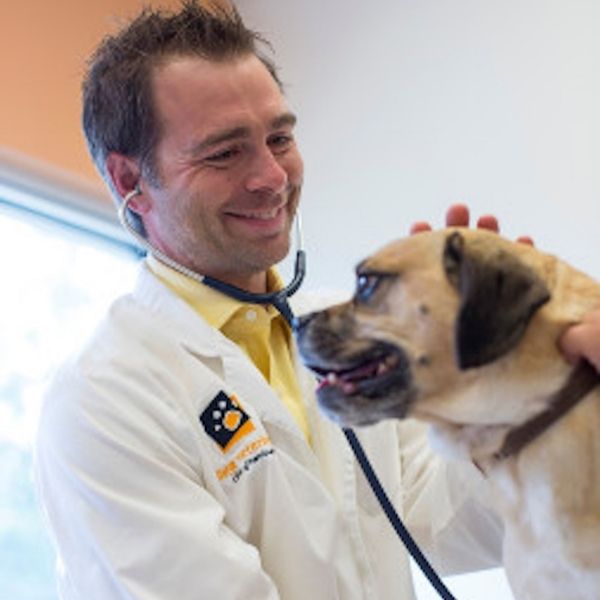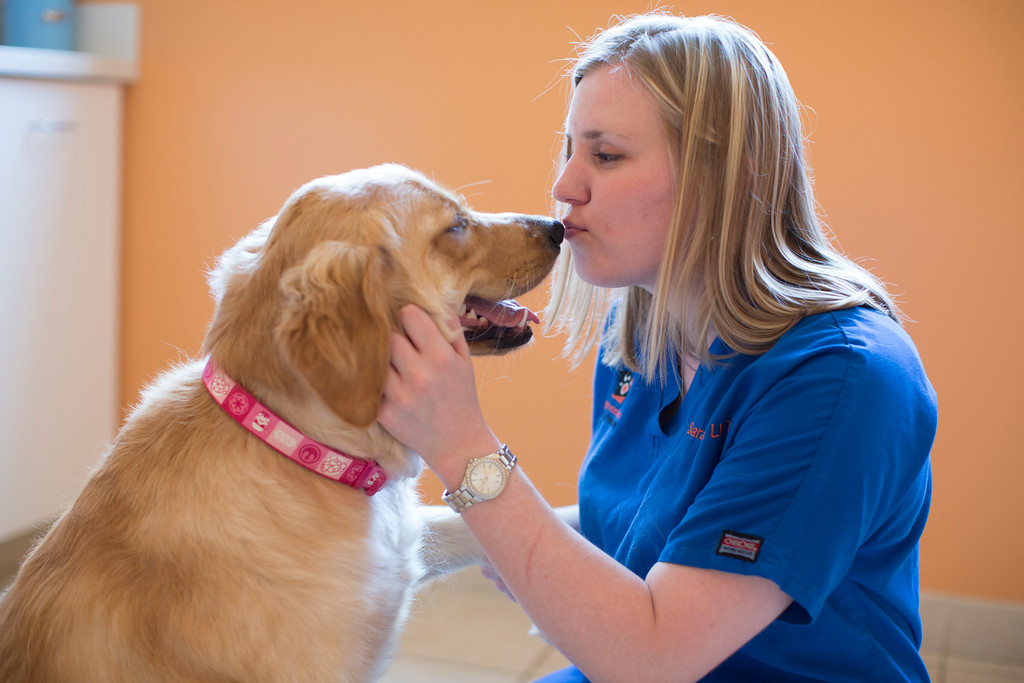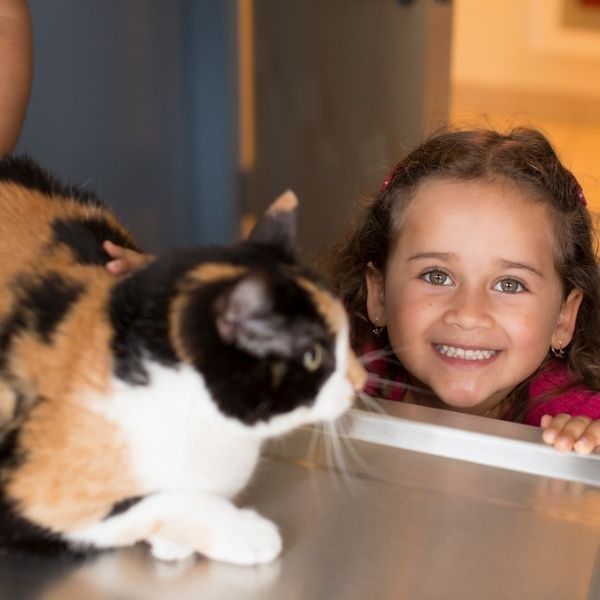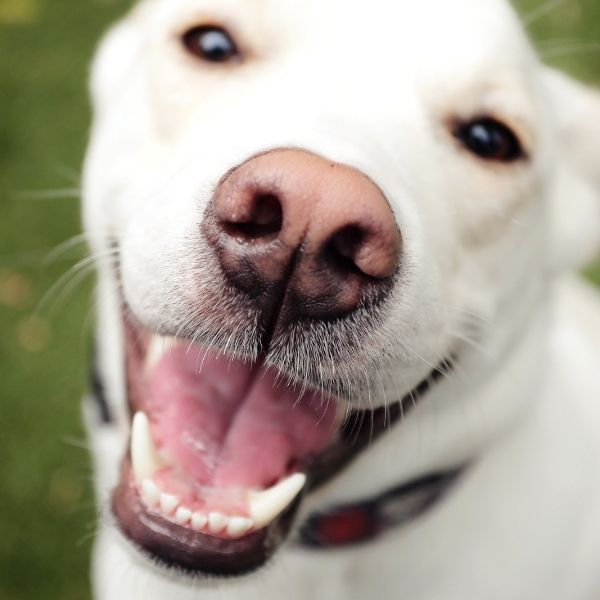Reduce Pet Fear
Free Your Pet From Fear

Before Your Visit
Let a member of the VVC team (customer service representative, technician) know on the phone when scheduling your appointment that your pet often reacts when traveling outside of the home. From there, go into detail about what upsets them.
- Does your cat (or dog) do well in the carrier?
- Does your dog not like to be around other dogs? Other people?
- Does your dog or cat react to loud noises (barking, other people chatting in the waiting room, phones ringing, etc)?
- Is your dog okay with people approaching them? Are they okay with people approaching them with you, the owner, present?
- Are they okay with having an examination done?
- Are they okay with having their temperature taken or vaccinations given?
- Are they better with or without you present for the exam and other procedures?
- Does your pet take treats well?
- Does your pet do well in the car?
- Does your pet like toys?
- Does your pet act sick in the car (drooling, vomiting, nauseous)?
By answering these questions and preparing the team here at the hospital ahead of your appointment, we can help better prepare your pet for their trip and their appointment.
Prepare for your visit
To help make our visits a positive experience, we offer treats during our examinations, blood draws, vaccinations, etc. We have cheese and peanut butter (along with hard treats and canned food) to help keep everyone happy! If medically able, it is best to bring your pet in hungry! You can also feel free to bring in a bag full of your pet’s favorite treats!
******Please make us aware if you or a family member has peanut, fish, cheese, or other food allergies.
- If your pet loves a certain toy and they feel most comforted by that, please bring that along as well.
- We are advocates of Feliway (cats) and Adaptil (dogs). These are synthetic pheromones that can create a sense of contentment and less stress. They come in plug-ins, so you can have them throughout your house. They come in a spray. You could spray a towel, blanket, or even bandana for them to wear to the vet.
- Don’t rush your pet. Leave plenty of time for them to go at their own pace. If you are stressed, they will feed off of that.
- If your pet gets car sick or is anxious in the car, a veterinarian can recommend medications to help alleviate nausea or vomiting.
- Help your cat adjust to the carrier prior to a visit. By leaving the carrier out days (even a week or two) prior to a visit, this can allow your cat to adjust to its presence. You can reward them with treats when they approach it or go in it. You can also leave the carrier door open so they are free to go in and out. Leaving treats in the carrier can help. Putting a Feliway sprayed towel can help to decrease the stress of going into the carrier. When transporting the carrier, try not to swing to jostle the carrier too much. Place a towel over it as well to help your cat stay hidden from the world.

How To Help
The fear-free behavior can all be built at a young and impressionable age- when they are puppies and kittens. Building a positive relationship with people, other pets, and the veterinarian is key. Going to the veterinarian is wonderful. They are able to see other dogs, meet new people- what’s not to love? During the early visits, we try to establish a positive and fear-free bond that will continue throughout their life. The goal during our visits is to always make it a positive experience for our pets. This can begin at home. For example, making the carrier a comforting place or the leash something fun to wear. Positive rewards instill positive bonds and behavior. At our visits, we encourage coming in with your dog or cat’s favorite treats, favorite toys, or even a favorite blanket. We want them to feel comforted and happy while at the hospital. We not only want long-term physical health but emotional/mental health as well!

Helping My Anxious or Fearful Pet
If your pet is stressed during a visit, meaning they seem hyperactive, panting, jumping up and down, trying to hide or just frozen, lashing out at people or dogs, we may need to consider a different tactic for your visit.
We want to make each visit comfortable for every animal. Addressing fear now and helping to decrease it will help to reduce the fear of future veterinary visits in their lifetime. Low fear veterinary visits are proven to be more effective and provide a higher quality of medicine for your pet over their lifetime.
We may prescribe medications to help reduce your pet’s anxiety. This medication is not to sedate your pet, but the primary function is to decrease your pet’s fear anxiety so they can have a pleasant and Fear Free experience. Fear is an uncontrollable emotion that causes a sudden massive surge in stress hormone. This is unhealthy for your pet. These medications have a wide safety margin and are regularly used in veterinary medicine.
Due to the individual responses and the variety of medications and doses, we may not get the response we are looking for the first time. This is unlikely but possible. We will create a plan that works for your pet’s specific needs.

Happy Visits
You may be asking, what is a happy visit? We want all our four-legged friends to walk through the doors at the VVC and have their tails wagging and be just that- happy! We understand that not everyone enjoys leaving the comforts of their own home to find out they are going to the vet. In order to help those fearful dogs, we have “Happy Visits”.
A happy visit is when we spend one on one time with your dog and our sole purpose is to build positive associations at the veterinary hospital. Instead of coming to the hospital and having a treatment or procedure done, we will walk your dog around the hospital and offer them snacks without asking for anything in return.
They are away from any stimuli that may cause them to become nervous or lash out. They instead are just left to observe their surroundings and get treats. We encourage petting and play. If they offer to hop up on an exam table, great! We will continue to feed cookies! If they become hesitant, we will just try to feed cookies near the exam table.
For the happy visits, it is helpful if you bring along your dog’s favorite treats, favorite toy, or whatever makes them most comfortable (bed, blanket). We want to build a positive association with being at the hospital. Then, when your dog returns for their examination, you may bring along those favorite treats and toys so that hopefully it can be just as fun as their happy visits.
When you arrive for your happy visit, consider leaving your dog in the car (weather permitting) while you are checking in, or call us from your cell phone to let us know that you have arrived. It is also encouraged to bring your pet in hungry (if medically able). That way one of our team members can have a room and everything ready to go when you enter the building. By avoiding the waiting room, we also avoid triggers and potentially stressful events, such as loud noises and strange smells. We also team members who are Fear Free certified that will make sure to always implement fear-free techniques.
A happy visit should be scheduled in advance in order to allow our team to spend time with your dog.
